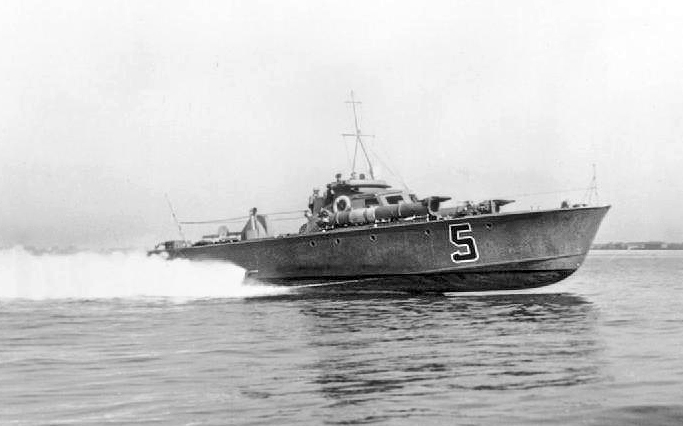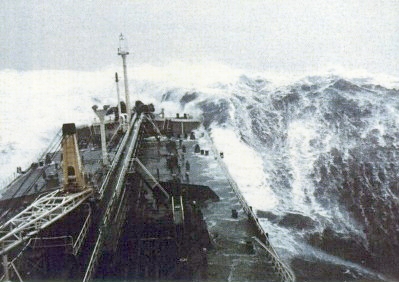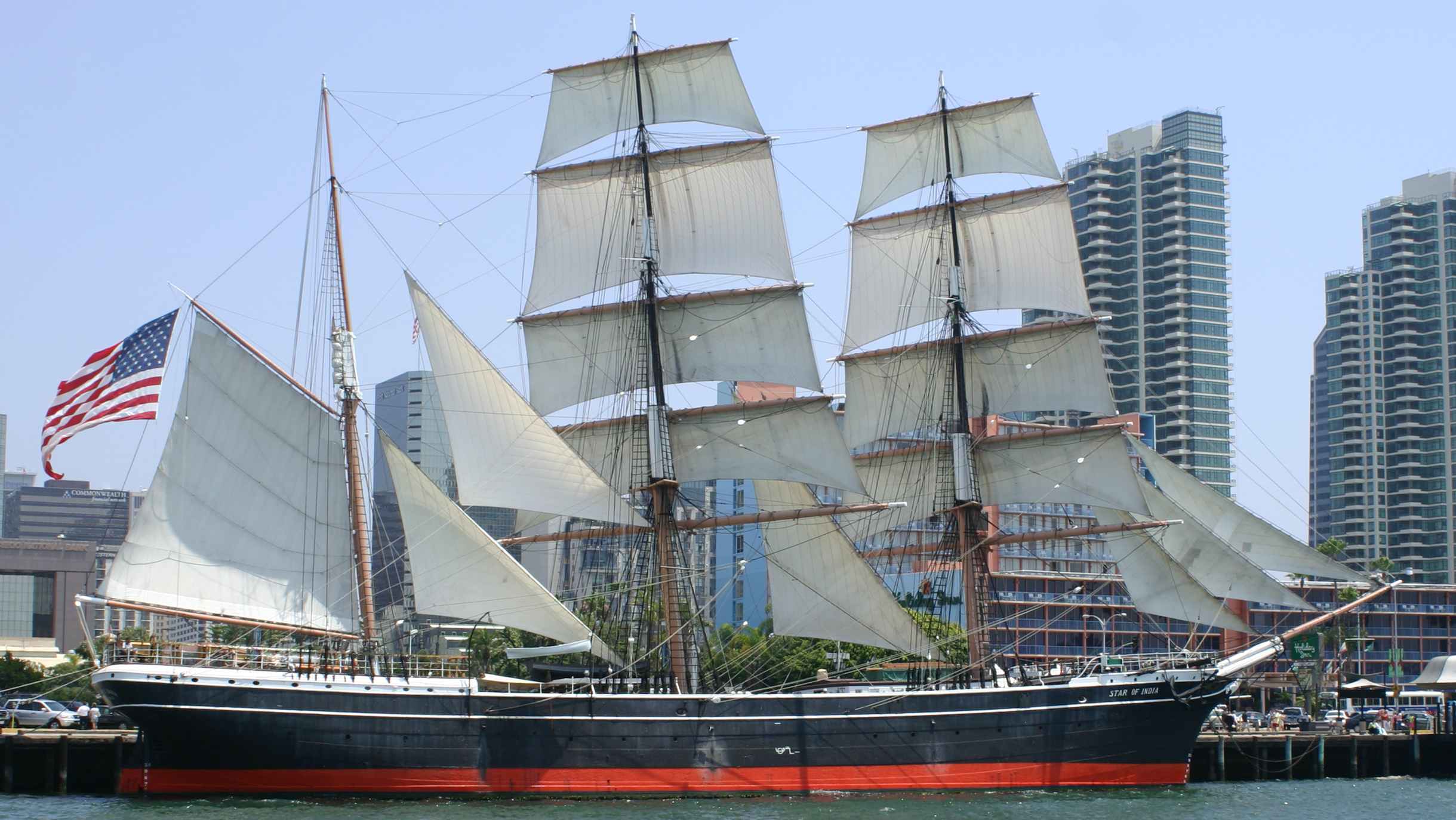|
Sunfish (dinghy)
The Sunfish is a personal-size, beach-launched sailing dinghy. It features a very flat, boardlike hull carrying an Oceanic lateen sail mounted to an un- stayed mast. Sunfish was developed by Alcort, Inc. and first appeared around 1952 as the "next generation" improvement on their original boat, the Sailfish. In contrast, the Sunfish has a wider beam for more stability, increased freeboard and the addition of a foot-well for a more comfortable sailing position. Sunfish began as a wood hull design and progressed to fiberglass construction just a few years after its introduction. Having a Lateen sail with its simple two line rigging makes a Sunfish simple to learn sailing on and to set up. Upgrades can be added to enhance sail control for competitive sailing, making the boat attractive to both novice and experienced sailors alike. Due to the broad appeal of the Sunfish, in 1995 it was commended by The American Sailboat Hall of Fame for being "the most popular fiberglass boat ... [...More Info...] [...Related Items...] OR: [Wikipedia] [Google] [Baidu] |
Monohull
image:monohull.svg, right A monohull is a type of boat having only one hull (watercraft), hull, unlike multihulled boats which can have two or more individual hulls connected to one another. Fundamental concept Among the earliest hulls were simple logs, but these were generally unstable and tended to roll over easily. Hollowing out the logs into a dugout canoe doesn't help much unless the hollow section penetrates below the log's center of buoyancy, then a load carried low in the cavity actually stabilizes the craft. Adding weight or Sailing ballast, ballast to the bottom of the hull or as low as possible within the hull adds stability. Naval architects place the center of gravity substantially below the center of buoyancy; in most cases this can only be achieved by adding weight or ballast. The use of stones and other weights as ballast can be traced back to the Ancient Rome, Romans, Phoenicians and Vikings. Modern ships carry tons of ballast in order to maintain their stabil ... [...More Info...] [...Related Items...] OR: [Wikipedia] [Google] [Baidu] |
International Sunfish Class Organization
International is an adjective (also used as a noun) meaning "between nations". International may also refer to: Music Albums * ''International'' (Kevin Michael album), 2011 * ''International'' (New Order album), 2002 * ''International'' (The Three Degrees album), 1975 *''International'', 2018 album by L'Algérino Songs * The Internationale, the left-wing anthem * "International" (Chase & Status song), 2014 * "International", by Adventures in Stereo from ''Monomania'', 2000 * "International", by Brass Construction from ''Renegades'', 1984 * "International", by Thomas Leer from ''The Scale of Ten'', 1985 * "International", by Kevin Michael from ''International'' (Kevin Michael album), 2011 * "International", by McGuinness Flint from ''McGuinness Flint'', 1970 * "International", by Orchestral Manoeuvres in the Dark from '' Dazzle Ships'', 1983 * "International (Serious)", by Estelle from '' All of Me'', 2012 Politics * Political international, any transnational organization of ... [...More Info...] [...Related Items...] OR: [Wikipedia] [Google] [Baidu] |
Hull Speed
Hull speed or displacement speed is the speed at which the wavelength of a vessel's bow wave is equal to the waterline length of the vessel. As boat speed increases from rest, the wavelength of the bow wave increases, and usually its crest-to-trough dimension (height) increases as well. When hull speed is exceeded, a vessel in displacement mode will appear to be climbing up the back of its bow wave. From a technical perspective, at hull speed the bow and stern waves interfere constructively, creating relatively large waves, and thus a relatively large value of wave drag. Ship drag for a displacement hull increases smoothly with speed as hull speed is approached and exceeded, often with no noticeable inflection at hull speed. The concept of hull speed is not used in modern naval architecture, where considerations of speed/length ratio or Froude number are considered more helpful. Background As a ship moves in the water, it creates standing waves that oppose its movement. Thi ... [...More Info...] [...Related Items...] OR: [Wikipedia] [Google] [Baidu] |
Planing (sailing)
Planing ( ) is the mode of operation for a waterborne craft in which its weight is predominantly supported by hydrodynamic lift, rather than hydrostatic lift (buoyancy). Many forms of marine transport make use of planing, including fast ferries, racing boats, floatplanes, flying boats, seaplanes, and water skis. Most surfboards are planing or semi-planing hulls. Beyond planing, fast vessel designs have seen a transition to hydrofoil designs. History The earliest documented planing sailboat was a proa built in 1898 by Commodore Ralph Munroe. It was capable of speeds of more than twice the hull speed. Planing a sailing dinghy was first popularised by Uffa Fox in Britain. In 1928 Fox introduced planing to the racing world in his International 14 dinghy, ''Avenger''. That year he gained 52 first places, 2 seconds, and 3 third places out of 57 race starts. This performance was noticed by other designers who further developed them. Over the years many dinghies have acquired the ... [...More Info...] [...Related Items...] OR: [Wikipedia] [Google] [Baidu] |
Chine (boating)
A chine in boat design is a sharp change in angle in the Cross_section_(geometry), cross section of a hull (watercraft), hull. The chine typically arises from the use of sheet materials (such as sheet metal or marine ply) as the mode of construction. Rationale of chines Using sheet materials in boat construction is cheap and simple, but whereas these sheet materials are flexible longitudinally, they tend to be rigid vertically. Examples of steel vessels with hard chines include narrowboats and widebeams; examples of plywood vessels with hard chines include sailing dinghies such as the single-chined Graduate (dinghy), Graduate and the double-chined Enterprise (dinghy), Enterprise. Although a hull made from sheet materials might be unattractively "slab-sided", most chined hulls are designed to be pleasing to the eye and hydrodynamics, hydrodynamically efficient. Hulls without chines (such as Clinker (boat building), clinker-built or Carvel (boat building), carvel-built vessels) u ... [...More Info...] [...Related Items...] OR: [Wikipedia] [Google] [Baidu] |
Running (sailing)
A point of sail is a sailing craft's direction of travel under sail in relation to the true wind direction over the surface. The principal points of sail roughly correspond to 45° segments of a circle, starting with 0° directly into the wind. For many sailing craft 45° on either side of the wind is a ''no-go'' zone, where a sail is unable to mobilize power from the wind. Sailing on a course as close to the wind as possible—approximately 45°—is termed ''beating'', a point of sail when the sails are ''close-hauled''. At 90° off the wind, a craft is on a ''beam reach''. The point of sail between beating and a beam reach is called a ''close reach''. At 135° off the wind, a craft is on a ''broad reach''. At 180° off the wind (sailing in the same direction as the wind), a craft is ''running downwind''. A given point of sail (beating, close reach, beam reach, broad reach, and running downwind) is defined in reference to the true wind—the wind felt by a stationary observe ... [...More Info...] [...Related Items...] OR: [Wikipedia] [Google] [Baidu] |
Beaufort Scale
The Beaufort scale is an empirical measure that relates wind speed to observed conditions at sea or on land. Its full name is the Beaufort wind force scale. History The scale was devised in 1805 by the Irish hydrographer Francis Beaufort (later Rear Admiral), a Royal Navy officer, while serving on . The scale that carries Beaufort's name had a long and complex evolution from the previous work of others (including Daniel Defoe the century before) to when Beaufort was Hydrographer of the Navy in the 1830s, when it was adopted officially and first used during the voyage of HMS ''Beagle'' under Captain Robert FitzRoy, who was later to set up the first Meteorological Office (Met Office) in Britain giving regular weather forecasts. In the 18th century, naval officers made regular weather observations, but there was no standard scale and so they could be very subjective – one man's "stiff breeze" might be another's "soft breeze". Beaufort succeeded in standardising the sc ... [...More Info...] [...Related Items...] OR: [Wikipedia] [Google] [Baidu] |
Sail Plan
A sail plan is a description of the specific ways that a sailing craft is rigged. Also, the term "sail plan" is a graphic depiction of the arrangement of the sails for a given sailing craft.> In the English language, ships were usually described, until the end of the eighteenth century, in terms of their type of hull design. Using the type of rig as the main type identifer for a vessel only became common in the nineteenth century. This is illustrated by the terminology for ships in the large fleet of colliers that traded to London from the coal ports of the Northeast of England (of which was a well-known example). Many of these full-rigged ships (square rigged on all of three masts) had the hull type "bark"another common classification was "cat". In the second half of the eighteenth century, the square sails on the mizzen were often eliminated. The resulting rig acquired the name of the hull type: initially as "bark" and soon as "barque". This explains the Royal Navy's descripti ... [...More Info...] [...Related Items...] OR: [Wikipedia] [Google] [Baidu] |
Bermuda Rig
A Bermuda rig, Bermudian rig, or Marconi rig is a configuration of Mast (sailing), mast and rigging for a type of sailboat and is the typical configuration for most modern sailboats. This configuration was developed in Bermuda in the 1600s; the term ''Marconi'', a reference to the inventor of the Radio#History, radio, Guglielmo Marconi, became associated with this configuration in the early 1900s because the wires that stabilize the mast of a Bermuda rig reminded observers of the wires on early radio masts. Description The rig consists of a triangular sail set aft of the mast with its Mainsail#Bermuda rig, mainsail raised to the top of the mast; its parts of a sail, luff runs down the mast and is normally attached to it for its entire length; its Tack (sailing), tack is attached at the base of the mast; its Parts of a sail, foot (in modern versions of the rig) controlled by a Boom (sailing), boom; and its Parts of a sail, clew attached to the aft end of the boom, which is control ... [...More Info...] [...Related Items...] OR: [Wikipedia] [Google] [Baidu] |
Aspect Ratio (wing)
In aeronautics, the aspect ratio of a wing is the ratio of its span to its mean chord. It is equal to the square of the wingspan divided by the wing area. Thus, a long, narrow wing has a high aspect ratio, whereas a short, wide wing has a low aspect ratio.Kermode, A.C. (1972), ''Mechanics of Flight'', Chapter 3, (p.103, eighth edition), Pitman Publishing Limited, London Aspect ratio and other features of the planform are often used to predict the aerodynamic efficiency of a wing because the lift-to-drag ratio increases with aspect ratio, improving the fuel economy in powered airplanes and the gliding angle of sailplanes. Definition The aspect ratio \text is the ratio of the square of the wingspan b to the projected wing area S, which is equal to the ratio of the wingspan b to the standard mean chord \text: \text \equiv \frac = \frac Mechanism As a useful simplification, an airplane in flight can be imagined to affect a circular cylinder of air with a diameter equal to th ... [...More Info...] [...Related Items...] OR: [Wikipedia] [Google] [Baidu] |
Genericized Trademark
A generic trademark, also known as a genericized trademark or proprietary eponym, is a trademark or brand name that, because of its popularity or significance, has become the generic term for, or synonymous with, a general class of products or services, usually against the intentions of the trademark's owner. A trademark is said to become ''genericized''—or, informally, to have suffered ''genericide''—when it begins as a distinctive product identifier but changes in meaning to become generic. This typically happens when the products or services which the trademark is associated with have acquired substantial market dominance or mind share, such that the primary meaning of the genericized trademark becomes the product or service itself rather than an indication of source for the product or service. A trademark thus popularised has its legal protection at risk in some countries such as the United States and United Kingdom, as its intellectual property rights in the trademark ... [...More Info...] [...Related Items...] OR: [Wikipedia] [Google] [Baidu] |
Brandname
A brand is a name, term, design, symbol or any other feature that distinguishes one seller's good or service from those of other sellers. Brands are used in business, marketing, and advertising for recognition and, importantly, to create and store value as brand equity for the object identified, to the benefit of the brand's customers, its owners and shareholders. Brand names are sometimes distinguished from generic or store brands. The practice of branding - in the original literal sense of marking by burning - is thought to have begun with the ancient Egyptians, who are known to have engaged in livestock branding as early as 2,700 BCE. Branding was used to differentiate one person's cattle from another's by means of a distinctive symbol burned into the animal's skin with a hot branding iron. If a person stole any of the cattle, anyone else who saw the symbol could deduce the actual owner. The term has been extended to mean a strategic personality for a product or company, ... [...More Info...] [...Related Items...] OR: [Wikipedia] [Google] [Baidu] |






.jpg)